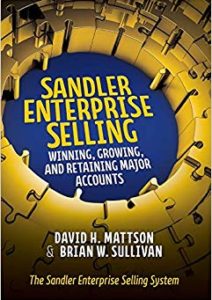Sales managers are quite familiar with the conversations that drive organizational decisions about whether to pursue major deals or to pass on them. Sales reps advocating pursuits will say, “It’s a big deal”, “It’s right in our power swing” or other similar reasons. But what do these reasons really mean? What’s the real business rationale for your firm in pursuing a major deal? And what’s the business risk?
In consulting with organizations selling into the enterprise space, I’ve often encountered start-up organizations that lack healthy lists of current accounts. It’s very common for such firms to be very lax on the “No” side of “Go/No-Go” decision-making, opting to pursue almost every deal that darkens their doors. But recently, I’ve seen more and more of this risky strategy from established selling organizations, perhaps a bit too eager to quickly win big deals, likely a result of pandemic hangover and a strong appetite to return to the “normal” selling environment of 2019. One CSO told me that “Go/No-Go” analyses have become simply pursuit kick-offs with every review becoming a “Go/Go-Go”. Rubber stamping done, they’re off and running to chase the whale. Human nature and optimism aside, such a risky and expensive strategy can only spell danger.
Think about it. I met with a Sales VP a few years back who told me that “Every opportunity we decide to pursue costs us $40,000. Win or lose, $40,000”. And in pursuing deals with enterprise accounts, whether your average cost is less than or greater than $40,000, the pain of the financial loss is proportionate. The point that the Sales VP made about financial impact of enterprise pursuits is compelling and painful. But it’s not the only cost. What about your human resources? To pursue major deals credibly involves your people and their precious time. And when they’re engaged in a pursuit, their talents are often unavailable to other organizational initiatives. And as we all know, everyone is busier now due to COVID. So, it’s especially important now to be attacking the highest probability deals, the true profile deals that align most closely to your capabilities. Those, of course, are the ones for which your probabilities of successful delivery, healthy margins and robust client satisfaction are highest. The importance of pursuing these optimal deals can’t be overstated, nor can exiting those that you’re unlikely to win or that don’t align to your profile. Taking such exit actions shuts down the cost flows and allows you to redeploy scarce resources on more fruitful initiatives, like deals that you’re more likely to win.
Early exit or early acceleration. Now, more than ever. But how do you know?
The process for answering that question begins with gaining a clear understanding of what your organization does well and what a truly aligned opportunity is. With clarity in those areas embedded in your organizational selling DNA, you then need a practical “Go/No-Go” process to evaluate the alignment and worthiness of opportunities. You start by breaking each opportunity’s key issues into three categories – Client Issues, Selling Team Issues and Contract Issues. And you evaluate each of these issues as a team with relevant representatives from throughout your organization participating to determine each issue’s stability or risk. That’s key. For every issue, are you stable or is there risk? Think about the issue of whether you have multi-level relationships in the account. Or whether you know who your competitors are and what relationships they have with the prospect organization. How about contractual guarantees, warranties or penalties that will likely be involved? Do you understand them well enough to gauge their risk? And for the issues where you’ve candidly identified risk, you build pragmatic mitigation action plans, as quickly as possible. The importance of addressing these issues as early as possible is critical. In significant deals, nothing good will come from ignoring a risk issue. Hope, as they say, is not a strategy.
The results of your risk mitigation efforts, which often involve direct discussions with the account, will either build your confidence in the deal or clarify your levels of dangerous risk, providing actionable information to drive your decisions. Of course, some measure of risk is to be expected in a major deal. But not risk you that you don’t evaluate or address. Acceptable risk is your call, but the call can’t be made without clearly understanding the impacts. Burying your head in the sand is no strategy. Neither is rubber stamping “Go/Go-Go” on every pursuit. With a pragmatic risk mitigation process, you’ll increase your chances of winning by choosing the right deals and forgoing the wrong ones. The right deals and the right strategy at just the right time.
Early exit or early acceleration. Yes, even now, when you’re starving for big wins. For your organization and all its stakeholders, they’re both gifts.















































Comments